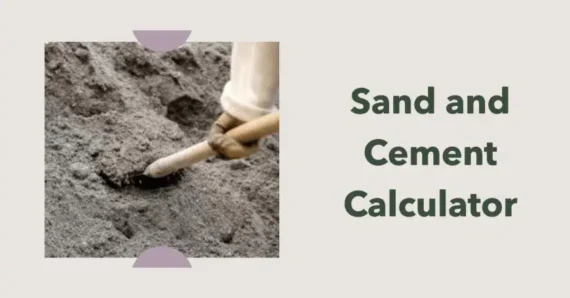Effortlessly estimate the amount of sand and cement needed for your construction project using our user-friendly sand and cement calculator
How to Use the Sand and Cement Calculator
- Enter the total volume (in cubic meters) of the area you want to fill with the sand and cement mix.
- Select the sand and cement mix ratio (cement: sand) from the dropdown menu. Our calculator supports three mix ratios: 1:3, 1:4, and 1:5.
- Click the “Calculate Materials” button to get the estimated amount of sand and cement needed for your project, displayed in kilograms.
Calculate Sand and Cement
Sand and Cement Calculator
Cement: 0 kg, Sand: 0 kg
Why Use a Sand and Cement Calculator?
Using a sand and cement calculator helps you save time and money by providing an accurate estimate of the materials needed for your construction project.
This enables you to plan ahead, order the right amount of materials, and avoid costly mistakes.
Additionally, using the right sand and cement mix ratio is crucial for achieving the desired strength, durability, and workability in your project.
Tips for Mixing and Using Sand and Cement
- Always follow the manufacturer’s guidelines for mixing sand and cement. This includes the correct mix ratio, mixing technique, and water content.
- Use clean, potable water when mixing sand and cement to ensure a consistent and strong mix.
- Mix the sand and cement in small batches to ensure it remains workable and does not harden before it can be used.
- Apply the sand and cement mix evenly and consistently to ensure proper bonding and strength in your project.
- Allow the sand and cement mix to cure properly, according to the manufacturer’s recommendations, to achieve the desired strength and durability.
How Does Sand and Cement Rendering Work?
FAQs
How does the sand and cement calculator work?
The sand and cement calculator estimates the amount of sand and cement needed for a project based on the inputted volume and desired mix ratio. It calculates the volume of sand and cement required and, using their densities, converts the volumes into weights in kilograms. This allows you to quickly determine the amount of sand and cement necessary for your construction project.
What are the typical mix ratios for sand and cement?
The most common mix ratios for sand and cement are 1:3, 1:4, and 1:5, with the first number representing the volume of cement and the second number representing the volume of sand. The specific mix ratio you should use depends on your project requirements, the type of sand and cement you’re using, and the desired strength and workability of the mix.
Can I use different types of sand for my sand and cement mix?
Yes, different types of sand can be used for sand and cement mixes, depending on the project requirements and the sand’s characteristics. Sharp sand, also known as builder’s sand or coarse sand, is commonly used in construction projects due to its good drainage properties and ability to bond with cement. However, always consult the manufacturer’s guidelines or a construction professional for recommendations on the appropriate type of sand for your specific project.
How should I store sand and cement to maintain their quality?
To ensure the quality of your sand and cement, store them in a cool, dry place, away from moisture and direct sunlight. Sand should be stored on a clean, hard surface or in a designated storage container to prevent contamination. Cement should be stored in its original, sealed packaging or a moisture-proof container to prevent exposure to humidity and moisture, which can cause the cement to harden and become unusable.
How can I determine the right amount of water to use when mixing sand and cement?
The amount of water needed when mixing sand and cement depends on the specific mix ratio, the type of sand and cement used, and the desired consistency of the mix. As a general guideline, start with a small amount of water and gradually add more until the mix reaches a workable consistency. It should be moist enough to hold together when squeezed but not too wet or runny. Always follow the manufacturer’s recommendations for water content and mixing procedures to achieve the best results.
Conclusion
This sand and cement calculator is an invaluable tool for construction professionals and DIY enthusiasts alike.
It enables users to accurately estimate the amount of sand and cement needed for a project based on the desired volume and mix ratio, streamlining the planning and budgeting process.
By providing precise calculations, it allows you to order the right amount of materials, preventing costly mistakes and ensuring the desired strength and workability of the mix.
Keep in mind the importance of using the right type of sand, adhering to the manufacturer’s guidelines, and allowing the mix to cure properly for optimal results.
With the help of a sand and cement calculator, you can confidently tackle your construction projects while maintaining efficiency and achieving high-quality results.
Author Profile

- I have many qualifications and certificates in construction, such as City & Guilds, CPCS and CITB. These are the highest standards of training and competence in the industry. Whether you need help with plumbing, carpentry, bricklaying or any other trade, I’m here to help you succeed.
Latest entries
- March 6, 2024CalculatorsWall Tile Calculator: How Many Wall Tiles Do You Need
- February 29, 2024Roof Truss Cost Calculator
- December 31, 2023Wage Take Home Calculator
- December 30, 2023Day Rate Calculator

